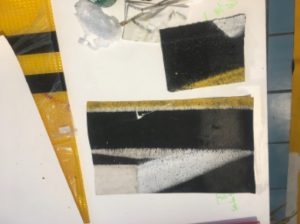PIT’s ‘Paint Pad’ Inspires New Industrial Painting
Artist-in-residence unveils signature piece drawn from the work and materials of airport crews
By Matt Neistein
Published March 1, 2019
Read Time: 2 mins
A year after Blaine Siegel dove headfirst into the daily life of Pittsburgh International Airport, he’s ready to show the world what he found.
Chosen as PIT’s Artist-in-Residence in 2018, Siegel immersed himself in the airport’s culture with an eye toward creating a signature piece of art inspired by his experience.

A sample of Blaine Siegel’s final project as PIT’s Artist-in-Residence. (Image courtesy of Blaine Siegel)
On Thursday, he unveiled that project for more than a dozen Allegheny County Airport Authority employees who have been closely following Siegel’s progress in the “AIR PIT” (Artist-in-Residence) program, one of only a dozen such programs worldwide.
PIT’s is conducted in partnership with the Greater Pittsburgh Arts Council’s Office of Public Art.
Early on, Siegel developed a fascination with PIT’s “paint pad,” a patch of asphalt where workers regularly test the machines and trucks used to maintain the wide-ranging and complex network of lines painted on and near runways, gates and other paved areas traversed by aircraft.
The paint pad’s ever-changing and random appearance immediately caught Siegel’s eye.
“There’s so many different directions I could have gone,” he said, but the pad “became integral to my identity here.”
Siegel finally settled on creating a series of industrial paintings literally made on that paint pad.

A sample of Blaine Siegel’s final project as PIT’s Artist-in-Residence. (Image courtesy of Blaine Siegel)
Long and narrow, the pieces are made of vinyl wallpaper laid on the asphalt while the machines were tested, leaving a wild array of black and yellow and white stripes. Siegel used roofing tiles to hold the vinyl down on the asphalt, and he’ll incorporate them into the art as well, while also making use of neon-colored baggage tags and airline tickets, among other materials.
He envisions the paintings being hung somewhere in the Airside Terminal’s Center Core, although a final location has yet to be determined by the airport. The art will be mounted on custom trestles built by airport tradesmen and then hung from a wall or support structure.
“Our team is thrilled with the final design that Blaine has proposed,” said Rachel Rearick, Airport Authority arts and culture manager. “The artwork will be a clear representation of his time spent engaging with crews at PIT, and it will afford passengers an opportunity to visualize elements of the aviation environment that they otherwise would not be aware of.”
Siegel also expressed interest in creating a smaller, accompanying piece that would be hung at the Allegheny County Airport in West Mifflin.
Watch
This Next
Read
This Next





